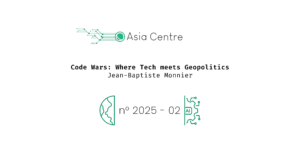Table ronde n°7 de l’Observatoire Chine, 26 janvier 2016, avec le Dr. Jagannath P. Panda (East Asia Centre, IDSA, New Delhi)
Over the past decades, the nature, composition, structure and function of Asia-Pacific institutions have changed. For instance, the Association of Southeast Asian Nations (ASEAN) was founded in 1967 to enhance
security and political cooperation within Southeast Asia. Today ASEAN gathers ten nations and its agenda now covers security, trade, investments and culture.
That is why these mechanisms are termed “New Institutions”. Some of them are backed by China, some others by the United States1. In this context, what is India’s role and response to these institutional initiatives in Asia-Pacific?
- India, Indo-Pacific and Asia-Pacific
- India’s strategy in Asia-Pacific
- New Institutions, Old evolving mechanisms and Institutional Order in Asia-Pacific
- India’s outlook towards the New Institutions in Asia-Pacific
- India, China and South China Sea
- Conclusion
- Questions and Answers




